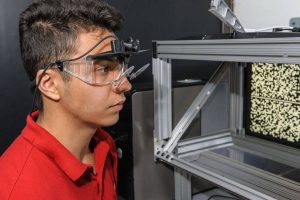This page provides just two of the many research papers that link Convergence Insufficiency (CI) with ADHD.
1. The Relationship Between Convergence Insufficiency and ADHD
Department of Ophthalmology, Ratner Children’s Eye Center, University of California, San Diego. Granet D.B., Gomi C.F., Ventura R, Miller-Scholte A. The relationship between convergence insufficiency and ADHD. Strabismus. 2005 Dec;13(4):163-8. https://www.ncbi.nlm.nih.gov/pubmed/16361187
Background:
Children being evaluated for attention deficit hyperactivity disorder (ADHD) often have an eye exam as part of their evaluation. The symptoms of convergence insufficiency (CI) can make it difficult for a student to concentrate on extended reading and overlap with those of ADHD.
Methods:
A retrospective review of 266 patients with CI presenting to an academic pediatric ophthalmology practice was performed. All patients included were diagnosed with CI by one author (DBG) and evaluated for the diagnosis of ADHD. A computerized review was also performed looking at the converse incidence of CI in patients carrying the diagnosis of ADHD.
Results:
We reviewed 266 charts of patients with CI. Twenty-six patients (9.8%) were diagnosed with ADHD at some time in their clinical course. Of the patients with ADHD and CI, 20 (76.9%) were on medication for ADHD at the time of diagnosis for CI while 6 (23.1%) were either not on medication or the medication was discontinued several months before the diagnosis of CI.
The review of computer records showed a 15.9% incidence of CI in the ADHD population.
Conclusions:
- We report an apparent three-fold greater incidence of ADHD among patients with CI when compared with the incidence of ADHD in the general US population (1.8-3.3%).
- We also note a seeming three-fold greater incidence of CI in the ADHD population
- Patients diagnosed with ADHD should be evaluated to identify the subset that may have CI — a condition that responds well to treatment at home.
2. Measuring ADHD Behaviors in Children with Symptomatic Accommodative Dysfunction or Convergence Insufficiency: A Preliminary Study
Southern California College of Optometry. Borsting E, Rouse M, Chu R. Measuring ADHD behaviors in children with symptomatic accommodative dysfunction or convergence insufficiency: a preliminary study. Optometry. 2005 Oct;76(10):588- https://www.ncbi.nlm.nih.gov/pmc/articles/PMC2888729/
Background:
Accommodative dysfunction and convergence insufficiency (CI) are common pediatric vision problems that have been associated with an increase in frequency and severity of vision-specific symptoms that affect children when doing schoolwork.
However, the relationship between accommodative dysfunction and CI and other learning problems, such as attention deficit hyperactivity disorder (ADHD), are not well understood. The purpose of this study was to evaluate the frequency of ADHD behaviors in school-aged children with symptomatic accommodative dysfunction or CI.
Methods:
Children 8 to 15 years of age with symptomatic accommodative dysfunction or CI were recruited from the teaching clinic at the Southern California College of Optometry. Children with learning disabilities or ADHD were excluded. One parent of each child completed the Conners Parent Rating Scale–Revised Short Form (CPRS-R:S). The children’s scores on the CPRS-R:S were compared with the normative sample.
Results:
Twenty-four children (9 boys and 15 girls) participated in the study with a mean age of 10.93 years (SD = 1.75). On the CPRS-R:S, cognitive problem/inattention, hyperactivity, and ADHD index were significantly different from normative values (p ≤ .001 for all tests).
Conclusion:
School-aged children with CI have a higher frequency of behaviors related to reduced school performance and attention.
Schedule an appointment with a vision therapy eye doctor to start a treatment program geared for CI.
SEE RELATED: How Is Convergence Insufficiency Diagnosed?
Comment from an eye doctor
You probably already know that the letters “ADHD” represent: Attention Deficit Hyperactivity Disorder. You may not be as familiar with convergence insufficiency, which optometrists call by its acronym, “CI”.
Convergence insufficiency, or CI, is a condition in which the patient has difficulty using both eyes together as a team in a near space, as occurs during reading or writing.
It might seem obvious that if a person has difficulty sustaining the use of both eyes together as a team, for an extended period of time such as when reading, that reading would be stressful.
In fact, many patients with CI handle their difficulty by frequently re-focusing their eyes by looking at a distant image, taking breaks, or avoiding the near vision task altogether.
For many years, that’s been obvious to us as developmental optometrists. In other words, a substantial number of patients who seek our care have a history of being able to attend very well when someone else is reading, but have a short attention span, or get antsy, when they have to read independently.
Many children appear to have ADHD when in reality, they have ‘visual inattention’— for a good reason.
The problem is that these patients are usually lumped together, and end up in special education, often medicated.
While a small set of patients with true ADHD may benefit from medication, precious resources and emotions would be saved if those with CI were properly evaluated. Many families would be spared from the anguish that results when homework completion takes hours too long, or when a spouse struggles to keep pace in the workplace— two common difficulties that result from visual inattention.
This study, by Dr. Granet and colleagues at UCSD, is notable because it is the first paper published in a medical journal that establishes a direct link between ADHD and CI.
- In a review of 266 charts of patients with CI, these researchers found a three times greater amount had ADHD than would be expected among patients in general.
- They emphasize that patients diagnosed with ADHD should be evaluated to determine if they have CI.
Studies of this nature should help call attention to children misidentified as having ADHD, while the underlying visual problem is left untreated.
This is particularly important because CI is one of the more common visual problems that developmental optometrists successfully treat through vision therapy.
In many instances, parents of pediatric patients, as well as adult patients have reported to us that after completing a program of vision therapy, their capacity to attend when reading, writing, or computing has improved substantially.
LEARN MORE: Vision Therapy for Children
Contact a vision therapy eye doctor to start a treatment program geared for CI.









